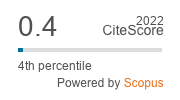Potential of Blaptostethus pallescens Poppius (Hemiptera: Anthocoridae) on Tetranychus truncatus Ehara (Prostigmata: Tetranychidae)
DOI:
https://doi.org/10.33307/entomon.v46i3.610Abstract
Efficiency, functional and numerical responses of anthocorid bug Blaptostethus pallescens Poppius on the spider mite, Tetranychus truncatus Ehara were examined under laboratory conditions. Nymphs of B. pallescens exhibited a Hollings type II functional response when females of spider mite were offered at densities of 10, 20, 30, 40, 50, 60 and 70 mites/bug. Individual fifth instar bugs consumed up to 45.3 adult females of T. truncatus in 24 h at prey mite densities of 60 mites/ bug. Studies on numerical response revealed that the nymphs of the anthocorid bug failed to complete development when the food was restricted to mite alone. Numerical response studies on adult bugs, when offered T. truncatus at densities of 10, 20, 30, 40 and 50 females showed no significant differences in the average fecundity of the female bug. Results indicate that the anthocorid predator, B. pallescens has a very high predatory potential though with a weak numerical response.


